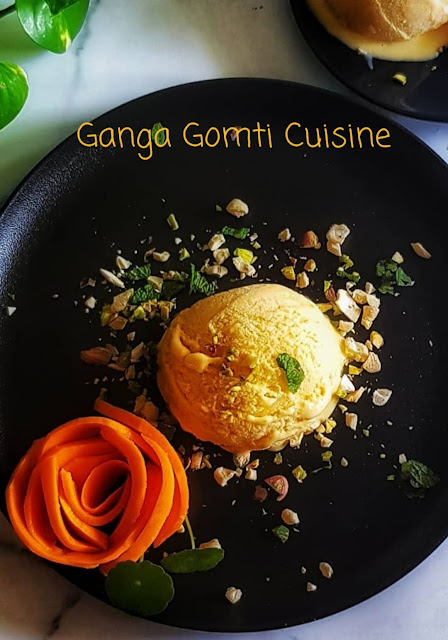Mango Icecream
Mango Icecream
Who doesn't scream for Icecream!!
Ice cream's origins are known to reach back as far as the second century B.C., although no specific date of origin nor inventor has been undisputably credited with its discovery. We know that Alexander the Great enjoyed snow and ice flavored with honey and nectar. Biblical references also show that King Solomon was fond of iced drinks during harvesting. During the Roman Empire, Nero Claudius Caesar (A.D. 54-86) frequently sent runners into the mountains for snow, which was then flavored with fruits and juices.
Over a thousand years later, Marco Polo returned to Italy from the Far East with a recipe that closely resembled what is now called sherbet. Historians estimate that this recipe evolved into ice cream sometime in the 16th century. England seems to have discovered ice cream at the same time, or perhaps even earlier than the Italians. "Cream Ice," as it was called, appeared regularly at the table of Charles I during the 17th century. France was introduced to similar frozen desserts in 1553 by the Italian Catherine de Medici when she became the wife of Henry II of France. It wasn't until 1660 that ice cream was made available to the general public. The Sicilian Procopio introduced a recipe blending milk, cream, butter and eggs at Café Procope, the first café in Paris.
Ice Cream for America
The first official account of ice cream in the New World comes from a letter written in 1744 by a guest of Maryland Governor William Bladen. The first advertisement for ice cream in this country appeared in the New York Gazette on May 12, 1777, when confectioner Philip Lenzi announced that ice cream was available "almost every day." Records kept by a Chatham Street, New York, merchant show that President George Washington spent approximately $200 for ice cream during the summer of 1790. Inventory records of Mount Vernon taken after Washington's death revealed "two pewter ice cream pots." President Thomas Jefferson was said to have a favorite 18-step recipe for an ice cream delicacy that resembled a modern-day Baked Alaska. In 1813, Dolley Madison served a magnificent strawberry ice cream creation at President Madison's second inaugural banquet at the White House.
The first mention of freezing water or cream is in the Indian collection of folk tales called the Panchatantra from the fourth-century, which tells us that “Water only becomes really cool when it contains salt”.

And this is the process that would be used to make ice cream from it's very beginnings right up until after the Second First War (when electric refrigeration started to spread). I remember my mom used to make ice cream by this process when we did not have refrigerator.
India's famous Kulfi Ice Cream
In 16th century India one of the gems of world ice cream arrived. Kulfi is first mentioned in the Ain-i-Akbari, the record of the life of the Moghul emperor Akbar the Great who reigned from 1556 to 1605.

Antique Kulfi Molds
The book describes saltpeter being used with ice from the Himalayas: clear evidence of the endothermic process in use.
Unlike many other of these early ice creams, the processes and flavors used to make Kulfi in India remain much the same today as they did in the 16th century!
Today I made this simple yet delicious Mango Ice cream with just 3 ingredients.....and no ice cream machine or eggs were used!
Ingredients:
- Mango -1 large or 2 medium(1 1/2 cup puree)
- Heavy whipping cream-1 1/2 cup
- Sugar-1/4 cup or according to taste
Method:
- Blend peeled and chopped mango with sugar.
- With the help of hand mixer, beat on medium speed till thick.
- Fold mango puree in the cream gently.
- Freeze for 4 hours covering with cling wrap and lid.
- After 4 hours, take this out and blend in the mixer jar for 1 minute.
- Transfer it into a glass container, again covering with cling wrap and lid and freeze for 5-6 hours.
- Garnish with your choice of nuts and saffron.



Comments
Post a Comment